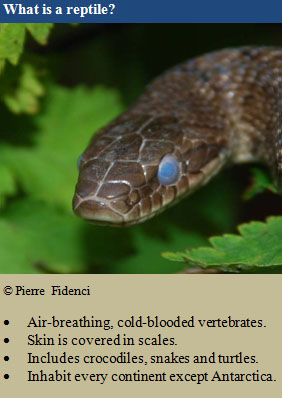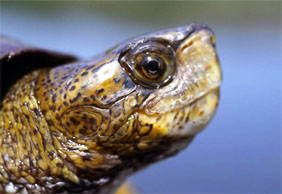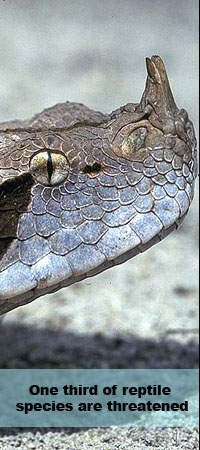|
Reptiles are members of the class Reptilia (from the Latin ‘repere’, “to creep”). The earliest reptiles appeared in the Carboniferous period (359-299 million years ago) but were overshadowed by the much larger amphibians of the time. It was only following a small ice-age that reptiles started to grow to much bigger sizes. Dinosaurs that roamed the Earth 230-65 million years ago belonged to the class Reptilia, and all mammals and birds alive today evolved from descendants of early reptiles.
Today, all living reptiles belong to one of four orders:
|
Order | Includes | No. of known species |
Crocodilia | Alligators, crocodiles, caimans and gavials | 23 |
Sphenodontia | Tuatara | 2 |
Squamata | Snakes, lizards and amphisbaenids | 8396 |
Testudines | Turtles, tortoises and terrapins | 313 |
Data from TIGR Reptile Database (2008)
Reptiles are ectothermic (cold-blooded) vertebrates, with scales instead of fur or feathers. They were the first animals to evolve amniotic eggs within shells, which allowed them to lay eggs on land. They have clawed toes, except of course for species such snakes, which have evolved to no longer use legs. The majority of reptile species have a three-chambered heart.
Due to their method of temperature regulation, most species of reptiles are found in warmer climates. Reptiles can be found in marine, fresh-water and terrestrial habitats, and on every continent except Antarctica. With the exception with some anurans, reptiles have cutaneous watReptiles play a major role in ecosystems. For example, in the Bahamas islands, lizards in the genus Anolis prey on spiders that eat herbivorous insects and can affect herbivore density and damage done to plants by herbivores. er-loss rates 50 to 1,500 times lower that of amphibians.
Reptiles play a major role in ecosystems. For example, in the Bahamas islands, lizards in the genus Anolis prey on spiders that eat herbivorous insects and can affect herbivore density and damage done to plants by herbivores.
Continue on page 2
|
|


Western pond turtle Actinemys marmorata is the only freshwater turtle native to the North American Pacific.
© Pierre Fidenci
|









